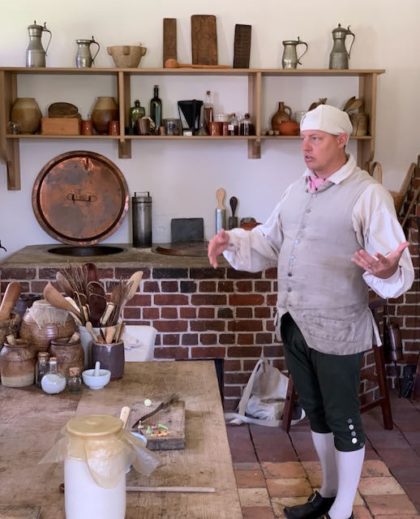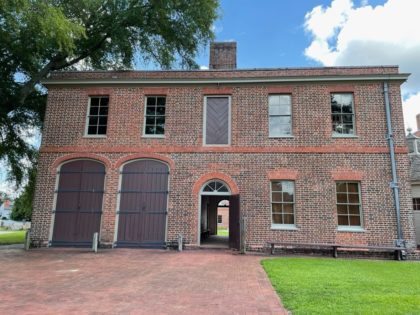Actor Tim Downie gives us a fiendishly fitting take on the corrupting power wielded by William Tryon, 8th governor of North Carolina, on the Outlander_Starz TV series. But as we learn from history, the concept of honor depends from which side of the mirror you view it. Did you know his wife was wealthy, but yet Tryon taxed colonists to build him a palatial home? Could it be the real Tryon was even more wily than his TV persona?
Perhaps so. Even as a young man William Tryon was an astute political climber who knew where fortune lay. A single man in his early soldiering days, he sired daughter Elizabeth Saunders out of wedlock. He supported his daughter and her mother even as he clung to bachelorhood, eventually marrying the intelligent and quirky British heiress Margaret Wake in London.
Like a heroine in a Georgian romance novel, Margaret brought a Mr Darcy-sized fortune of 30,000 pounds sterling (approximately $7 million in today’s dollars) to their marital union. Doubly fortunate for Tryon, she also brought political connections that would yield rich personal bounty in the form of her relative “Wills” Hill, Viscount Hillsborough. According to Paul David Nelson, author of William Tryon and the Course of Empire, “It was through Hillsborough’s influence that Tryon became lieutenant governor of North Carolina in 1764, governor of the same colony in 1765, and governor of New York in 1771.” Today’s North Carolina town of Hillsborough reflects that influence in its street names of Wake, Tryon, King and Queen.
Making canny decisions in the military and social ranks, Tryon came into his power more fully when he took up his commission as royal lieutenant governor in the American colonies. Not only did he own enslaved people while in North Carolina, it is said he was known as “the Wolf” by the region’s Cherokee peoples whom he forcefully obliged to cede game-rich hunting lands to the ruling British king, George III and the encroaching European settlers. While Tryon might have understood the colonials’ resistance to being taxed by a government thousands of miles across the ocean, his loyalty was ever to King and Country. (There’s that pesky mirror again.)
After many a dispute with the unhappy locals in Wilmington, NC, where he was first based after assuming full leadership, Tryon and his bride Margaret—who insisted on being addressed as “Her Excellency”—pulled up stakes. They and their 13 household staff, 11 of whom had come along from England, left that coastal town for the bustling burg of New Bern. It was hoped he could more happily rule the increasingly fractious colony from near the confluence of the Trent and Neuse Rivers and away from the irritated residents of Wilmington. All seemed to go well for the Tryons, with both enslaved people and free workers to serve their needs and work on their three-level Georgian-styled, home.
The North Carolina Assembly approved funding for the building, but when the Tryons overspent and demanded yet more taxes from hardscrabble farmers and mountain folk living hand-to-mouth in the western region, the fuse of insurrection was lit. While he may have initially tried diplomacy in North Carolina, Outlander series author Diana Gabaldon makes it clear that the Tryon-Colonial honeymoon phase was short lived. Enraged locals labeled the building “Tryon’s Palace,” and Tryon soon defaulted to brutality in his attempt to subdue the North Carolina people, which came as a stark reminder of George III’s stranglehold on the throats of all American colonists. Tryon’s excessive taxation of the colonists and his increasing political demands sparked a powder keg of anger, further fueling the Regulators who’d had more than enough of British interference.
The Governor and Mrs Tryon lived only one year in the completed home designed by British architect John Hawks before they moved on to the New York colony in 1771. The gracious residence fell out of governmental service when the capitol was moved yet again to the more centrally located town of Raleigh, which remains the state capitol today. The original Tryon Palace eventually burned down in 1798. Thankfully, the work of five remarkable women and countless donations brought the history and the building itself back to life. It was reconstructed on its original foundation in the 1950s, based on a surviving copy of the original floor plan. The gorgeous Stable Office immediately adjacent to the residence survives intact to this day.
Tryon Palace sits along the Trent river, near the North Carolina History Center in the lovely town of New Bern. The Palace staff welcome visitors into the beautifully restored main building, acres of gardens and outlying historic homes daily, with tours starting every 30 minutes weekdays. Times and ticket prices vary. Do check the online ticketing site at www.tryonpalace.org for complete information about the Outlander – The Spark of Rebellion and other tours available.
OUTLANDER – SPARK OF THE REBELLION
One Saturday per month, Tryon Palace and its staff host special Outlander tour events. These are held outside and move around the beautiful exterior grounds. Visitors are treated to interpreters/re-enactors reprising settlers from the Outlander era.
Our tour began with saucy wenches Sherry and Sarah fielding questions about life in the 18th century, even explaining things such as why a revolutionary woman would “follow the drum” and/or stay with husbands and sons during war times. (Preventing the French pox could be key!) Interpreters know their history (and their Outlander references) and made for fun sessions at each stop. There is an additional charge for the tour, but it made the visit even more worthwhile.
Apothecaries were visited for herbs and concoctions to serve as preventatives, but surgeons were called for pain relief, from lancing a wound to removing a limb according to interpreter Charles.











